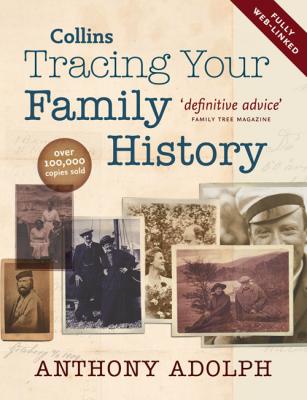Collins Tracing Your Family History. Anthony Adolph
Читать онлайн.| Название | Collins Tracing Your Family History |
|---|---|
| Автор произведения | Anthony Adolph |
| Жанр | Справочная литература: прочее |
| Серия | |
| Издательство | Справочная литература: прочее |
| Год выпуска | 0 |
| isbn | 9780007373567 |
Many people were important or well known in their time but are not considered so by posterity. There have been many biographical dictionaries past and present, not least Who’s Who (OUP), which has been published annually since 1897, and its accompanying Who Was Who (OUP), concerning the deceased, both of which are combined on a CD-Rom version. Here you will find the great and the good, from holders of public office to captains of industry, the top brass in the armed forces, the upper echelons of the clergy, and also writers, artists, editors and a host of others. Brief details are provided of dates of birth, marriage, death, parents and offspring. It is more useful for providing a date of birth so you can seek a birth certificate than in actually providing adequate genealogical details in its own right – but, of course, the biographical information it contains is marvellous.
From hip to history:Linda McCartney’s tragically early death means she has joined Princess Diana in the Oxford Dictionary of National Biography.
Besides these, there are many further biographical dictionaries relating to specific groups in society, like the armed forces or religious groups, which are discussed in the appropriate chapters.
RECORD SOCIETY PUBLICATIONS
Many county record offices and archives have published indexed volumes transcribing some of their original records. The Lancashire and Cheshire Record Society, for example, has published many of its counties’ wills, royalist composition papers, freemen records and much else. Trawling through these can throw up all sorts of treasures.
The easiest way of finding out what has been published is through E. L. C. Mullins’ Texts and Calendars: An Analytical Guide to Serial Publications, Vol. I (RHS, 1958) and Vol. II, 1957–1982 (RHS, 1983), D. and W. B. Stevenson’s Scottish Texts & Calendars: An Analytical Guide to Serial Publications (Royal Historical Society, London) and Scottish Royal Historical Society (Edinburgh, 1987). These may save you very lengthy searches through original records.
THE SOCIETY OF GENEALOGISTS
MANY PUBLISHED and even manuscript family histories have been deposited at the Society of Genealogists. Their catalogue is therefore a sort of superbibliography of work done previously. As of 2005, the catalogue can be searched online at www.sog.org.uk/sogcat/index.html. Many family histories can also be seen online at www.lib.byu.edu/fhc.
SPECIALIST INDEXES
A catch-all to the many weird and wonderful indexes out there is J. Gibson and E. Hampson’s Specialist Indexes for Family Historians (FFHS, 1998). This covers topics as diverse as Congregational and Baptist ministers at Dr William’s Library, London (see here); multiple births worldwide; memorial cards (1846–1980); criminal registers in TNA class HO 27 (1805–92); members of the Ancient Order of Foresters; and much else.
RESEARCH DIRECTORIES
Besides magazines, journals and an increasingly huge number of websites, many private researchers are also listed in special directories and for a small fee you can be listed too, with your name, address and the names you are interested in, with specific periods and countries, if applicable. The best known directories are the Genealogical Research Directory and the Federation of Family History Societies’ British Isles Genealogical Research Directory, commonly known as the ‘Big R’, which is now available on CD-Rom. If making contact by post, be aware of the widely practised code of conduct: always to enclose SAEs. Some people will not reply to correspondents who do not do so, even if they are offering valuable information or are long-lost cousins. Online equivalents to these directories are the many websites that put people in touch with those with similar interests, particularly www.genesreunited.co.uk (see here).
WHERE TO SEARCH
EXAMPLES OF ARCHIVES IN OTHER COUNTRIES
Many people living in Britain were born abroad and many more have ancestry from overseas. Most have national archives or equivalents. To find them, you can consult www.cyndislist.com or T. F. Beard with D. Demong’s How to Find your Family Roots (McGraw-Hill Book Company, 1977). Besides Europe, these are countries that will contribute most significantly to the ancestry of people living in Britain over the next few generations, and their archive details are given here.
INDIA
In 1947, the records of the HEIC were transferred to the British Library’s Oriental and India Office Collections, known as the India Office Library, whose records are comprehensively described in M. Moir’s A General Guide to the India Office Library (British Library 1988). The library’s vast collections are very well indexed and has a biographical index, which brings together details on individuals from many of its sources, including records of birth, baptism and so on. These can be found at http://indiafamily.bl.uk/UI. Records include ships’ passenger lists for those coming and going – and a vast many did, either with the army or in some civil capacity
In addition to the wealth of material at the India Office, the SoG has a formidable collection relating to the British in India, not least the India index, containing much biographical data. The Indiaman, a magazine covering the British in India, has launched a wesbite www.indiaman.com. In India the main archives are the National Archives of India.
PAKISTAN AND BANGLADESH
KENYA
JAMAICA
